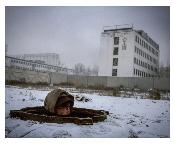How Many Gregarious Mongolians Are There?
 When I visited Mongolia 15 years ago, a young man approached us on the streets of Ulan Bator and offered to show us around. His name was Soyoloo, and we spent a few fun days hanging out with him.
When I visited Mongolia 15 years ago, a young man approached us on the streets of Ulan Bator and offered to show us around. His name was Soyoloo, and we spent a few fun days hanging out with him.
I have many fond memories of Mongolia, so this NYT piece on Ulan Bator’s underground homeless population immediately caught my attention. The first picture is of a man named Soyoloo. I wondered if this was the same Soyoloo I met so long ago.
How likely is that? A naive estimate looks like this: half of the one million people in Ulan Bator are men, so there’s a 1 in 500,000 chance that a randomly-selected (that is, randomly photographed) man from Ulan Bator is the man I met 15 years ago. At 0.0002%, this does not seem very likely.
But here’s where conditional probability comes in. The man in the photograph isn’t just any randomly-selected man; he’s a randomly-selected man named Soyoloo. What I really want to know is, given the condition that a randomly selected man from Ulan Bator is named Soyoloo, what is the probability that he’s the man I met 15 years ago?
Naturally the answer depends on how many men in Ulan Bator are named Soyoloo. “Soyoloo” doesn’t appear on any list of most popular Mongolian names, so I am going to estimate that at most 0.5% of Mongolian men are named Soyoloo (this would be roughly equivalent to ‘Andrew’ in the US, the 35th most popular male name). This means that at most 2,500 men (0.5% of 500,000) in Ulan Bator are named Soyoloo. Therefore, if a man in Ulan Bator named Soyoloo is selected at random, there is a 1 in 2,500 chance (0.04%) it’s the man I met.
This is the power of conditional probability. The man in the photograph and the man I met share a common characteristic: being named Soyoloo. Knowing this condition greatly alters the probability that they are the same person.
In fact there’s another characteristic the two men share: they are both comfortable striking up relationships with foreign strangers, whether it’s me or a photojournalist. Let’s call this characteristic gregariousness. Now the question is, what is the probability that a randomly-selected gregarious male resident of Ulan Bator named Soyoloo is the person I met 15 years ago?
Well, how many gregarious Mongolians are there? Let’s say 5% of all Mongolians are gregarious. Then there are roughly 125 gregarious Mongolian men named Soyoloo in Ulan Bator, and thus, a 1 in 125 (0.8%) chance that the man in the photo is the same man I met. Not a lock, but not a longshot, either!
This probability may seem surprisingly high, given the distance in both time and space, but I have a feeling it’s him. His eyes look warmly familiar.
1 Comment
Amy Hogan · March 13, 2013 at 9:31 pm
I’m not a betting woman but I’d bet that it IS the same person. And here’s why… I’m certain that there are more factors that are present that would up the odds. What these factors are is the million-dollar question.
What are the chances that I would bump into my neighbor unexpectedly in another country? What are the chances that I would see someone I know at the airport? What are the chances that I would meet someone who was born at the same hospital as me within hours of my own birth (even though we didn’t grow up together)? What are the chances that I bump into a friend on the street in Manhattan (not anywhere near where either of us live or work)?
These are all seemingly really small probabilities too, right? And, yet, these things have happened to me. It’s happened to me enough that I don’t think of it as so unlikely anymore.
Social networking theory really is beginning to make sense to me.